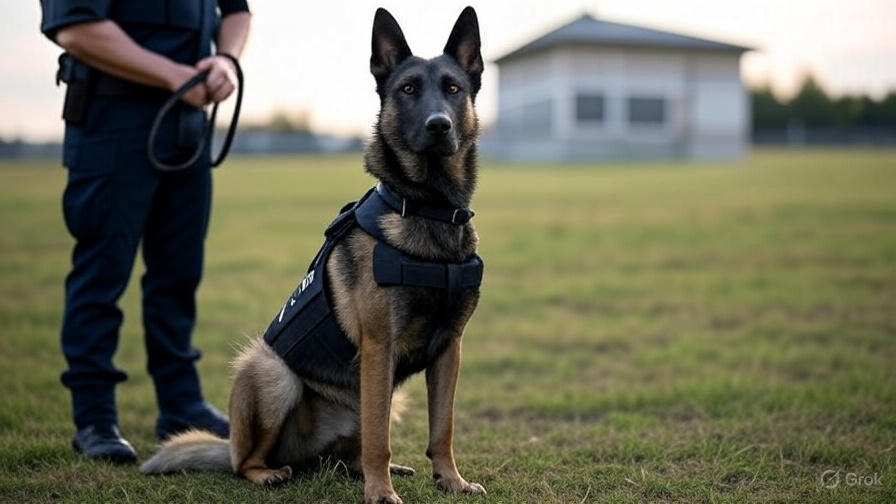How Are Police Dogs Trained?
Police dogs serve as essential partners in law enforcement, protecting communities and supporting officers in dangerous situations. These remarkable animals undergo rigorous training programs that transform them from ordinary pets into highly skilled working dogs. The training process involves multiple phases, specialized techniques, and continuous reinforcement to ensure these canines can perform their duties effectively.
The Foundation: Early Selection and Assessment
Law enforcement agencies begin the training process by carefully selecting dogs with the right temperament and physical abilities. Most police departments work with specialized breeding programs or purchase dogs from reputable European trainers who have already begun basic training.
German Shepherds, Belgian Malinois, and Dutch Shepherds dominate the police dog world due to their intelligence, loyalty, and physical capabilities. These breeds possess natural drive, strong work ethic, and the ability to bond closely with their handlers. The selection process evaluates each dog’s prey drive, social confidence, and response to stress.
Trainers assess potential candidates through various tests that measure their reactions to loud noises, unfamiliar environments, and different people. Dogs that show excessive fear, aggression, or lack of focus get eliminated from the program. Only the most promising candidates advance to formal training.
Basic Obedience Training: Building the Foundation
The initial training phase focuses on establishing basic obedience commands that form the foundation for all future specialized training. Dogs learn essential commands like sit, stay, come, heel, and down through positive reinforcement techniques.
Trainers use food rewards, praise, and play to motivate dogs during this phase. The training sessions occur multiple times daily, with short, intensive periods that maintain the dog’s attention and enthusiasm. Dogs must demonstrate complete reliability with basic commands before progressing to more advanced training.
Handler bonding begins during this phase as well. The officer who will work with the dog starts building a relationship through feeding, grooming, and training sessions. This bond becomes crucial for effective teamwork in the field.
Specialized Training Programs
Police dogs receive training in various specializations based on their intended role within the department. The most common specializations include patrol work, narcotics detection, explosives detection, and search and rescue operations.
Patrol Dog Training
Patrol dogs undergo training in protection work, tracking, and area searches. These dogs learn to apprehend suspects, protect their handlers, and search buildings for hidden individuals. The training involves controlled scenarios where dogs practice biting and releasing on command.
Trainers use bite suits and protective equipment to safely teach dogs proper bite techniques. Dogs learn to target specific areas of the body and release immediately when commanded. This training requires careful balance between developing the dog’s protective instincts while maintaining complete control.
Tracking training teaches dogs to follow human scent trails over various terrains and weather conditions. Dogs learn to differentiate between different scents and follow specific tracks while ignoring distractions. This skill proves invaluable when searching for fleeing suspects or missing persons.
Detection Dog Training
Detection dogs specialize in locating specific substances through their exceptional sense of smell. These dogs can detect narcotics, explosives, firearms, or even electronic devices depending on their training.
The training begins with introducing dogs to target scents in controlled environments. Trainers hide small amounts of the target substance and reward dogs when they locate and indicate the source. Dogs learn specific alert behaviors like sitting, pointing, or pawing to signal their findings.
Detection training progresses from simple hiding places to complex scenarios that mirror real-world situations. Dogs practice searching vehicles, buildings, luggage, and outdoor areas. They learn to work systematically and thoroughly while maintaining focus despite distractions.
Training Techniques and Methods
Modern police dog training relies heavily on positive reinforcement techniques that build strong working relationships between dogs and handlers. Trainers use various motivational tools including food rewards, toy play, and verbal praise to encourage desired behaviors.
The training follows a systematic approach where complex behaviors get broken down into smaller, manageable steps. Dogs master each component before moving to the next level of difficulty. This progressive training ensures solid foundations and reduces the likelihood of behavioral problems.
Consistency plays a crucial role in police dog training. All trainers and handlers use identical commands, signals, and reward systems to avoid confusing the dogs. This standardization allows different officers to work with the same dog when necessary.
Environmental Training and Socialization
Police dogs must work effectively in various environments and situations. Training includes exposure to different locations, surfaces, weather conditions, and crowd situations. Dogs practice working in schools, airports, busy streets, and other locations where they might be deployed.
Socialization training helps dogs remain calm and focused around civilians, other animals, and unusual situations. Dogs learn to ignore distractions while maintaining their working focus. This training prevents inappropriate reactions that could compromise operations or endanger the public.
Noise desensitization forms an important part of environmental training. Dogs gradually become accustomed to gunshots, sirens, loud machinery, and other sounds commonly encountered in police work. This preparation ensures dogs won’t be startled or distracted by sudden noises during operations.
Handler Training and Certification
While much attention focuses on dog training, handlers must also complete extensive training programs. Police officers learn dog psychology, training techniques, proper handling methods, and legal requirements for using police dogs.
Handler training covers reading canine body language, recognizing signs of stress or illness, and maintaining the dog’s health and fitness. Officers learn to interpret their dog’s alerts and behaviors accurately to make appropriate tactical decisions.
The handler-dog team must pass rigorous certification tests before becoming operational. These tests evaluate the team’s performance in various scenarios including obedience, detection work, and protection exercises. Regular recertification ensures teams maintain their skills and effectiveness.
Ongoing Training and Maintenance
Police dog training never truly ends. Working dogs require continuous training throughout their careers to maintain their skills and learn new techniques. Daily training sessions keep dogs sharp and reinforce learned behaviors.
Training programs adapt to emerging threats and changing law enforcement needs. Dogs might receive additional training in detecting new types of explosives, drugs, or other substances. This flexibility ensures K-9 units remain effective against evolving criminal activities.
Physical fitness training maintains the dogs’ health and working ability. Dogs participate in regular exercise programs that include running, swimming, and agility work. Proper conditioning prevents injuries and extends the dogs’ working careers.
Common Challenges in Police Dog Training
Training police dogs presents several unique challenges that trainers must address. Some dogs develop behavioral issues that require specialized intervention. Others may lose motivation or become distracted during training sessions.
Weather conditions can significantly impact training effectiveness. Rain, snow, extreme heat, or cold temperatures affect both dog performance and scent detection abilities. Trainers must adapt their methods to work effectively in all conditions.
Liability concerns require careful attention to proper training procedures. Improperly trained dogs can cause injuries or fail to perform when needed. Thorough documentation of training procedures and regular assessments help minimize these risks.
The Role of Technology in Modern Training
Modern police dog training increasingly incorporates technology to enhance effectiveness and safety. Video analysis helps trainers identify areas for improvement in both dog and handler performance. GPS tracking systems monitor training progress and document search patterns.
Simulation training uses realistic scenarios to prepare dogs for specific situations they might encounter. These controlled environments allow for repeated practice without the unpredictability of real incidents. Virtual reality systems even help handlers practice decision-making skills.
Remote training tools enable trainers to work with dogs at greater distances and in more realistic scenarios. Electronic collars provide precise timing for corrections and reinforcement. These tools, when used properly, enhance the training process without causing harm to the dogs.
Career Longevity and Retirement
Police dogs typically work for 6-8 years before retiring, though some continue working longer if they remain healthy and effective. The training investment in each dog represents significant time and resources, so departments strive to maximize their working careers.
Retirement planning begins early in a dog’s career. Handlers often adopt their retired partners, maintaining the bond formed during their working relationship. Some retired police dogs transition to less demanding roles in schools or community programs.
The training legacy continues as experienced dogs sometimes help train new recruits. Their calm demeanor and reliable responses provide excellent examples for young dogs just beginning their careers.
International Training Standards and Practices
Police dog training practices vary significantly between countries and regions. European training methods often emphasize different techniques than those used in North America. International exchanges allow trainers to learn from different approaches and improve their programs.
Certification standards ensure quality and consistency across different training programs. Organizations like the National Police Canine Association establish minimum requirements for police dog teams. These standards help maintain public trust and operational effectiveness.
Cross-training programs expose dogs and handlers to different techniques and specializations. This broad training base makes teams more versatile and effective in various situations. It also provides career development opportunities for both dogs and handlers.
Future Developments in Police Dog Training
The field of police dog training continues evolving as new research reveals better training methods and techniques. Scientific studies of canine behavior and learning provide insights that improve training effectiveness and reduce the time required for certification.
Genetic research helps identify dogs with optimal traits for police work. This knowledge allows breeders to produce dogs better suited for specific roles. Improved selection processes reduce training failures and increase success rates.
Specialized training programs address emerging threats and changing law enforcement needs. Dogs now train to detect electronic devices, cryptocurrency hardware, and other modern contraband. This adaptability ensures K-9 units remain relevant and effective.
Conclusion
Police dog training represents a complex, multi-faceted process that transforms ordinary dogs into skilled law enforcement partners. The training requires expertise, patience, and significant resources, but the results justify the investment. These remarkable animals serve communities by detecting dangerous substances, apprehending criminals, and protecting their human partners.
The success of police dog programs depends on proper selection, systematic training, and ongoing maintenance of skills. As law enforcement needs evolve, training programs must adapt to address new challenges while maintaining the high standards that make these dogs so valuable.
The bond between police dogs and their handlers creates effective teams that serve with distinction throughout their careers. This partnership, built through careful training and mutual respect, exemplifies the potential for human-animal cooperation in protecting public safety.







